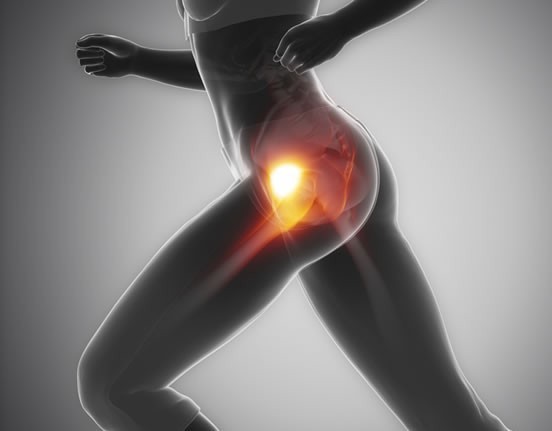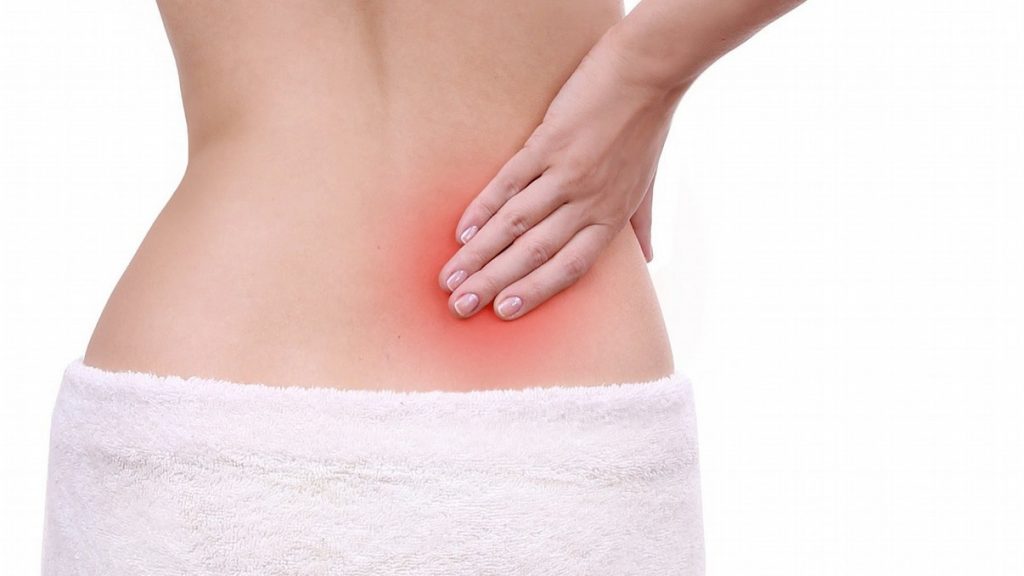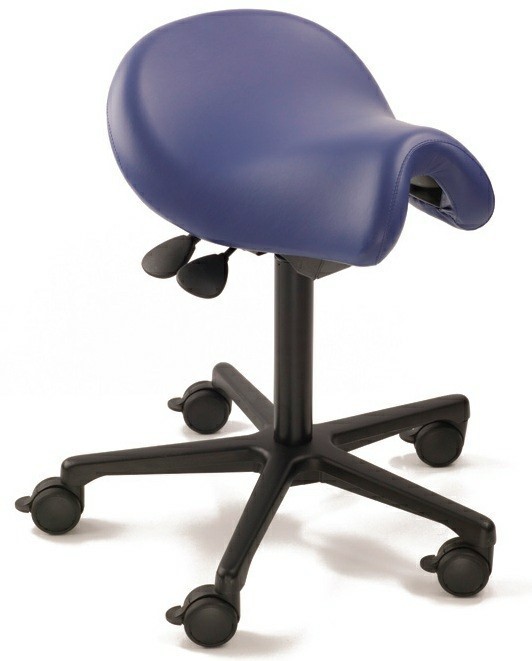
What are the most common hip problems?
- Hip joint pain or stiffness due to degenerative changes or sub-optimal joint shape. The joint is deep so the pain is often difficult to localize. Pain can be sharp or a dull ache, and usually varies with joint movement.
- Bursitis – an inflammation or degeneration of bursa (fat pads). These are designed to help muscles and tendons glide easier over adjacent structures such as bones and other muscles. Pain can vary from a broad throbbing ache to sharp and focused.
In the picture below, the hotspot could be hip joint or trochanteric bursitis pain. Bursa pain is usually reproduced by pressing your fingers into the flesh around the bone here.
Many people get pain over the rear part of the hip bone as in the picture below. This can spread further to the side and into the buttocks. This is not hip generated pain, but a referred pain from the lower back.
OK, here’s my top 5 recommendations for healthier pain free hips.
- Saddle Up!
The hip joints and bursa, like all body tissues, last longer and recover from use better, with nutritionally rich blood flow and lubrication. These are better when the joints are in the ‘loose packed position’.
This is when the tissue holding the joint together is loosest. Blood and lubricant can then more freely travel through all the structures of the joint (capsule, ligaments, cartilage, and bone). The bursa benefit similarly in this position.
So what is the loose packed position of the hips? Sitting on a horse in a saddle!
To be more precise, the hip joint is bent forwards approx. 30 degrees and to the side 30 degrees, with the knees and toes turned slight outwards.
Now, typical chairs in which we sit with a 90 degree bend at the hips and thighs close together are not ideal for good hip circulation. A healthier chair would emulate sitting on a horse, and there’s now a good range on the market (links below). These were designed primarily to stop sitter’s spines from slumping backwards and causing back problems. Nevertheless, they are also excellent for the hips.
The first saddle chair (Bambach) was designed by an Australian Occupational Therapist for disabled people who have trouble sitting in normal chairs, and yet sit well in a saddle. The Bambach took off globally and are very popular with dentists and laboratory scientists who sit still for long periods.
http://www.bambach.com.au/ http://salli.com/en/chairs https://backapp.eu/en/
In addition to saddle sitting, we would also benefit from mixing up sitting postures. Instead of sitting in normal chairs for hours a day, the following are associated with less back and hip pain in traditional cultures.
- sitting cross legged
- full squatting
- kneeling on heels
These communities generally have healthier hips, backs, knees, ankles, and feet! Though it helps to start at a young age, not carry excess weight, and eat a good diet.
- Less Running
Western civilisation has some pretty odd behaviours. Some of these came about as our leisure time increased such as jogging in the 1970s.
Now running hundreds of km’s year after year without developing hip issues, requires the hip joint surfaces and angulations be ideal for absorbing associated shock and stress; and that we minimize the shock with good running technique and low bodyfat %. Unfortunately, the majority of Westerners just do not have these traits. Hence, many of us who try to clock up the k’s, end up causing early osteoarthritis and degenerative changes of the hips (and knees).
If you do enjoy running, beware that often we do not develop hip or knee pain until damage is advanced.
If you must run or walk to de-stress;
- it is better on natural surfaces (grass and dirt tracks as opposed to roads and footpaths)
- do shorter runs more regularly (4 x 5km/wk, rather than 2x10km/wk)
- mix up running with other cardio (swimming is best at preserving lower limb function, cycling, rowing, circuit workouts)
- do 1-2 strength and stretch workouts a week that include legs and core.
I have had several ultra marathoner clients who argue scientific studies show runners have good cartilage preservation of hips and knees. What they don’t realise is these studies suffer selection bias. Long term runners who end up subjects for these studies have skeletal bio mechanics more suited to running. The majority of us don’t, and we shouldn’t take advice from these enthusiasts.
Finally it is wise to ask yourself why you enjoy running, if you do. Science shows runners get chemically addicted to the enkephalin and endorphin high, which helps relieve life stress. There’s less damaging ways to de-stress!
Effects of Running and Walking on Osteoarthritis and Hip Replacement Risk https://www.ncbi.nlm.nih.gov/pmc/articles/PMC3756679/
Hip osteoarthritis and the active patient: will I run again? https://www.ncbi.nlm.nih.gov/pmc/articles/PMC3535123/
- Noble Walk
Stress forces effecting the hip joint can be reduced significantly by walking with good posture and grace.
Key points:
- stand tall, looking forwards able to make eye contact with others; shoulders neutrally by the side.
- take a not too long step, that allows you to land lightly on the heel
- roll fluidly forwards onto the mid foot
- toe off with intent, but not aggressively
- keep the knee and hip relaxed at toe off, and allow the leg to swing rearwards with relaxed momentum. A stiff hip joint with reduced extension range commonly inhibits
- stay relaxed through the hips and spine
This will disperse shock through all joints more evenly rather than mostly at the hip joints, thereby preserving cartilage better into old age.
Stressed people tend to take too long a stride resulting in heavier heel strike; or they walk with the centre of gravity behind the hips more so. Both these wear the hip prematurely.
- The right shoes
Avoid high heels. They push the pelvis forwards which makes the hip joint use a different area of cartilage not optimised for walking. The cartilage is thinner and therefore wears quicker. Ligaments across the front of the hip also are loaded with additional tension when standing, which compromises circulation.
Avoid shoes with little heel cushioning when walking on hard surfaces.
Get appraised for orthotics. Many people who have flatter arches also have undesirable inwards rotation of the hip joint (femoral anteversion). This will wear the hip cartilage quicker and lead to labral tears.
- Healthy Diet = Healthier Hips
It is futile to talk about healthy hips without talking about optimising nutrition, hydration, mechanical loading, and recovery times.
Familiarise yourself with the Australian Dietary Guidelines.
http://www.nutritionaustralia.org/national/resource/australian-dietary- guidelines-recommended-daily-intakes
The three main points are :
- vegetables and salads are extremely important. Most Aussies don’t eat the recommended minimum
- eat starches less processed
- choose leaner meats
- hydrate adequately, beginning early in the morning
Good nutrition along with healthy body weight are the most powerful way for most people to keep hips healthier!


